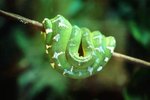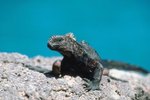
Roadrunners -- two bird species in the Geococcyx genus and members of the cuckoo family, Cuculidae -- inhabit desert and scrub areas of the southwestern United States, where they feed and build nests in scattered brush and grasses. Their harsh living environments are responsible for some of the adaptations that help roadrunners survive.
Sunshine Safeguard
During the day, roadrunners combat the scorching desert heat by decreasing their activity by 50 percent. Instead of using energy for hunting when then sun is at its hottest, for instance, these birds rest in the shade of a quiet shrub. Overnight, as temperatures drop, roadrunners' body temperatures decrease 7 degrees as the birds go into states of torpor, whereby they suppress their metabolism to reserve energy and prevent additional heat loss to their environment. As the sun comes up in the morning, the birds lift up patches of feathers on their backs, exposing their heavily pigmented skin. This skin acts as solar panels to absorb heat and increase their body temperatures.
Water Acquisition
In the desert, supplies of water are not always available. Roadrunners evolved a method of hunting to ensure they have access to water even when there is none available: Roadrunners are opportunistic omnivores, meaning they eat both plant and animal matter. Plant matter the consume includes seeds from grass, milkweed and nightshade plans, sumac berries and prickly pear cactus. Plant matter is more commonly consumed by roadrunners in the winter when animal prey are scarce. Animal prey includes large insects, spiders, scorpions, snakes, mice and lizards. These food items provide roadrunners with the water content and energy they need to survive.
Reuse and Recycle
Roadrunners adapted another essential means of retaining water: While digesting meals, they absorb excess water from their feces before excreting it. Roadrunners have small and large intestines. As omnivores, they have longer and more coiled small intestines than birds who are carnivores. Their small intestines are lined with villi, fingerlike projections that increase the surface area of the intestines and absorb water through blood vessels. Since the food of omnivore birds has a longer distance to travel than food in carnivores, more water is swept up by the villi and absorbed into the bloodstream.
Toss the Salt
Unlike other species of birds, roadrunners must get rid of excess salt from their bodies to stay hydrated. Roadrunners have salt glands above their eyes that remove excess salt from their blood. These glands are common in seabirds who drink saltwater but not common in most land birds. The glands are essential in desert birds like roadrunners, since they do not always have ready access to water.
On the Run
Despite their respectable wingspans -- they average 19 inches -- roadrunners can stay airborne for only several seconds at a time. These birds therefore walk and run much more than they fly. They have zygodactylous feet, which consist of two toes facing frontward and two toes facing backward per foot. Roadrunners can run at speeds up to an impressive 17 miles per hour. They need to be able to run quickly to hunt and to escape predators such as skunks, house cats, raccoons, coyotes and hawks.
References
- University of Michigan: Geococcyx Californianus
- The Cornell Lab of Ornithology: Greater Roadrunner
- California Wildlife Foundation: Greater Roadrunner
- The Nature Conservancy: Roadrunner
- Arizona-Sonora Desert Museum: Greater Roadrunner
- Chicago Zoological Society: Roadrunner
- The Real Roadrunner; Martha Anne Maxon
- Eastern Kentucky University: Digestive System - Food and Feeding Habits
- The Illustrated Encyclopedia of North American Birds: An Essential Guide To Birds Of North America; MobileReference
Photo Credits
-
Tom Brakefield/Stockbyte/Getty Images
Writer Bio
Amanda Williams has been writing since 2009 on various writing websites and blogging since 2003. She enjoys writing about health, medicine, education and home and garden topics. Williams earned a Bachelor of Science in biology at East Stroudsburg University in May 2013. Williams is also a certified emergency medical technician.




